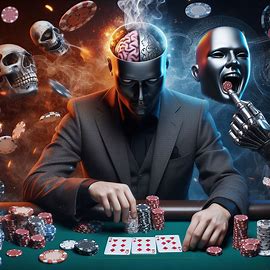Bluffing and Beyond: Psychological Warfare in Casino Poker
In the high-stakes environment of casino poker, the battle for supremacy extends far beyond the physical cards dealt. At the core of this contest is a complex game Warfare in Casino Poker of psychological warfare, where bluffing is merely the opening gambit in a much deeper strategy. This article delves into the intricate dance of minds that unfolds at the poker table, exploring the tactics that define the art of psychological manipulation and the profound impact they have on the game’s outcome.
The Art of Bluffing
Bluffing, the act of deceiving opponents about the strength of one’s hand, is the most renowned psychological tactic in poker. However, its effectiveness hinges on more than just the ability to keep a straight face. Successful bluffing requires a deep Warfare in Casino Poker understanding of opponents’ perceptions and strategies, turning each hand into a carefully choreographed performance designed to mislead and manipulate. It’s not just about convincing others that you hold a winning hand but also about timing, frequency, and the ability to abandon the bluff if circumstances change.
Reading the Tells
Equally critical to the psychological arsenal is the skill of reading “tells”—subtle physical or behavioral signs that give away information about a player’s hand or intentions. Mastery in this area allows players to see beyond the cards, making decisions based Warfare in Casino Poker on the psychology and tendencies of their opponents. The challenge lies in discerning genuine tells from those that are deliberately misleading, a complex interplay that adds a rich layer of strategy to the game.
The Pressure Play
Applying pressure at critical moments can force opponents into difficult decisions, leading them to make mistakes. This tactic involves aggressive betting patterns, strategic raises, and the occasional calculated risk to unsettle opponents and assert dominance at the table. The psychological impact of constant pressure can lead to “tilt”—a state of emotional frustration that can cloud judgment and lead to suboptimal play, further benefiting the aggressor.
Establishing a Table Image
How a player is perceived at the table—their “table image”—is a powerful tool in psychological warfare. A player known for tight, conservative play can surprise opponents with an unexpected bluff, while a reputation for aggression can make even a modest bet seem threatening. Manipulating one’s table image requires a long-term strategy and adaptability, as changing dynamics and player turnover at the table can necessitate a shift in approach.
Mental Resilience and Control
The psychological battle of casino poker is not just about manipulating opponents but also about maintaining one’s mental fortitude. Resilience in the face of losses, the ability to remain focused under pressure, and emotional control are crucial. Players must manage their own psychological state to prevent giving away tells or falling victim to the manipulations of others. This inner game of poker is often what separates the greats from the merely good.
Conclusion
The psychological warfare of casino poker is a multifaceted and dynamic aspect of the game that demands as much skill and strategy as the physical play. Bluffing, reading tells, applying pressure, managing one’s table image, and maintaining mental resilience are all critical components of a successful poker strategy. In the end, poker is not just a game played on the felt; it’s a contest of minds, where understanding human nature and mastering the art of psychological manipulation can lead to triumph. In this arena, the most successful players are those who excel not just in playing their cards but in playing the player across from them.
